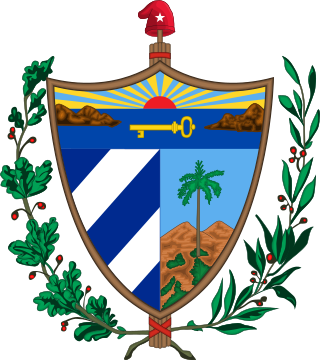
Trinidad is a town in the province of Sancti Spíritus, central Cuba. Together with the nearby Valle de los Ingenios, it has been a UNESCO World Heritage Site since 1988, because of its historical importance as a center of the sugar trade in the 18th and 19th centuries. Trinidad is one of the best-preserved cities in the Caribbean from the time when the sugar trade was the main industry in the region.

Matanzas is the capital of the Cuban province of Matanzas. Known for its poets, culture, and Afro-Cuban folklore, it is located on the northern shore of the island of Cuba, on the Bay of Matanzas, 90 kilometres (56 mi) east of the capital Havana and 32 kilometres (20 mi) west of the resort town of Varadero.

Nuevitas is a municipality and port town in the Camagüey Province of Cuba. The large bay was sighted by Christopher Columbus in 1492.

San Antonio de los Baños is a municipality and town in the Artemisa Province of Cuba. It is located 26 km from the city of Havana, and the Ariguanabo River runs through it. It was founded in 1802.

Nueva Gerona is a Cuban city, capital of the Isla de la Juventud special municipality and province. As of 2012, its population was 59,049.

Florida is a municipality and city in the Camagüey Province of Cuba. It is located 40 km (25 mi) north-west of Camagüey, along the Carretera Central highway. The city was established in 1907, and the municipality was established in 1924. Of all the municipalities of the Cuban province of Camagüey, Florida is third in area size. The name is Spanish for Land of flowers.

Jaruco is a municipality and town in the Mayabeque Province of Cuba.

Consolación del Sur is a municipality and town in the Pinar del Río Province of Cuba. Also called the Athens of Vueltabajo, it was founded in 1690.

Güira de Melena is a municipality and town in the Artemisa Province since January 1. of 2011, before it was part of the Havana province. Cuba. It is located on the southern shore of the island, bordering the Bay of Batabanó and on the west part of Cuba. It was founded in 1779.

Bejucal is a municipality and town in the Mayabeque Province of Cuba. It was founded in 1713. It is well known as the terminal station of the first railroad built in Cuba and Latin America in 1837. It also hosts one of the most popular and traditional carnival fest in Cuba: "Charangas de Bejucal". Bejucal has also been known as a telecomunications site, hosting broadcasts of several news and media networks. It was also host to Soviet nuclear warheads during the Cuban Missile Crisis.

The provinces of Cuba are divided into 168 municipalities or municipios. They were defined by Cuban Law Number 1304 of July 3, 1976 and reformed in 2010 with the abrogation of the municipality of Varadero and the creation of two new provinces: Artemisa and Mayabeque in place of former La Habana Province.
The Palacio de los Capitanes Generales is the former official residence of the governors of Havana, Cuba. Located on the eastern side of the Plaza de Armas in Old Havana it is home to the Museum of the City of Havana. It houses exhibitions of art and historical artefacts and many of the rooms are preserved with their original Colonial decoration.

Candelaria is a municipality and town in the Artemisa Province of Cuba. Before 2011 it was part of Pinar del Río Province. It was founded in 1809, and established as a municipality in 1880.

Sierra de Cubitas is a municipality in the Camagüey Province of Cuba. The municipal seat is located in the town of Cubitas.

Primero de Enero is a municipality and town in the Ciego de Ávila Province, Cuba. Originally named Violeta, its name means "1st of January" in Spanish, and is referred to the final day of Cuban Revolution.

Najasa River is a river of southern Cuba.















